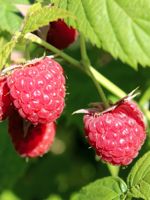Mon-Fri 9am - 5pm Mountain time
Boyne Raspberry vs Bilberry
Vaccinium myrtillus
Rubus sp. Boyne
CUSTOM GROW
Bilberry is a native perennial shrub valued for its small, blue-black berries that ripen in mid to late summer. The berries resemble blueberries but have a richer, more tart, and intense flavor. They have long been used for fresh eating, baking, and preserves, while also providing food for birds and mammals. In spring, its delicate pinkish flowers attract bees and other pollinators.
Growing low to the ground, Bilberry forms spreading colonies that create dense understory cover. This growth habit provides food and shelter for wildlife, and its foliage adds seasonal interest by turning red to purple in autumn. With its adaptability and ecological benefits, Bilberry is well-suited for naturalization, ecological restoration, and pollinator gardens.
The Boyne Raspberry is a classic red raspberry, with a deep red color and juicy, sweet taste. It’s great for fresh eating, desserts and jams. It is a medium-sized shrub that produces ready to pick heart-shaped berries from early to mid summer and is high-yielding.
Boyne Raspberry is a floricane-fruiting variety, meaning it primarily produces fruit on second-year canes (previous season’s new growth). They are also referred to as summer-bearing. In late winter or early spring, cut back all spent floricanes, leaving only last season's canes.
Raspberries are self-fertile, meaning they do not require cross-pollination from another variety to produce fruit.
Bilberry Quick Facts
Boyne Raspberry Quick Facts
Toxicity: leaves may be unsafe in high doses

